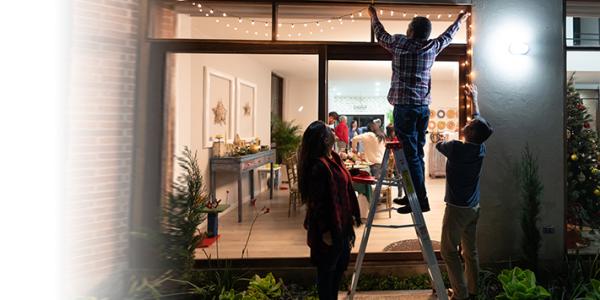Decorating your home is a sure way to help usher in a holiday mood. The lights, sounds and smells of the season are something most of us look forward to all year – along with transforming our homes and offices into a cheery and welcome space. But according to the Consumer Product Safety Commission, more than 18,000 Americans end up in the ER for injuries caused by holiday décor every year. And Christmas trees are responsible for nearly 200 home fires each year. That doesn’t mean your home can't be a holiday showpiece, or that you can't create the perfect festive environment inside your home. Just take a few precautions and follow these tips to help ensure that your holiday decorating is fun, beautiful and safe!
Indoors
- Is a fresh tree essential for your holidays? If so, make sure you get a fresh one! More than 50% of all tree fires occur between December 22 and January 5 – when trees start to dry out. Help avoid any mishaps by buying the freshest tree you can find, and then water it regularly. A fresh tree will have needles that bend between your fingers (rather than break) and are hard to pull from the branches, and the trunk will have sticky resin. Avoid trees with brown branches, or those that shower the ground with needles when shaken a bit.
- At home, cut about two inches off of the trunk so it will absorb water better. Set it up in a sturdy base with feet that are wide enough to keep it from wobbling. Add water to the base daily -- a six-foot tree will absorb about a gallon of water every day!
- Set the tree up at least three feet away from fireplaces, radiators, lights or candles. Ensure it’s not blocking exits, doorways, or footpaths.
- Use only lights that are rated for indoor use by an independent testing laboratory, such as Underwriters Laboratory. A "UL" on the tag means the lights have been inspected for fire and electrical safety. A green UL mark means that lights are safe for indoor use only, and a red mark means they are safe for indoor or outdoor use.
- Examine lights carefully for any frayed or exposed wires, cracked sockets, broken cords and loose or missing bulbs, and replace any showing signs of wear or damage.
- Don’t overload outlets or extension cords. Follow manufacturer guidelines for the number of strings you can connect – but never more than three.
- For both indoor and outdoor lights, consider purchasing LED lights which burn cooler and use less electricity.
- Always turn off and unplug the lights when leaving the house or going to bed.
- If your tree starts shedding needles, it's time to get rid of it – no matter what the calendar says. Dispose of it properly, and never leave a dried tree in the garage or leaning against the house. If you opt for an artificial tree, make sure it's fire-retardant and has a UL mark indicating it's safe.
- Install fresh batteries in your smoke detectors and check that they are working properly.
- Run long extension cords against the wall to avoid accidental tripping.
- Extinguish all candles before leaving the house or going to bed. Never leave burning candles unattended in areas that can be accessed by toddlers or pets.
- Place breakable ornaments and decorations with sharp or removable parts out of reach of children and pets. Consider replacing metal hooks with ribbons to secure ornaments to the tree.
Outside
- Use a ladder that extends at least three feet above your roof or the surface you are attaching decorations to. Never stand on your toes or the highest rung. The second rung from the top is as high as you should climb.
- Use the 4-to-1 rule: for every four feet of distance between the ground and the point of contact where you are placing the decorations, move the base of the ladder out one foot.
- Wear slip-resistant shoes and avoid clothes with hanging drawstrings or loose material that can get in your way or trip you up.
- Only use lights that are rated for outdoor use (see above).
- Make sure lights are secured and affixed to the structure in a way that does not harm the insulation wrapping the wire.
- Use heavy-duty extension cords that are designated for outdoor use.
- All lights should be plugged into a Ground Fault Circuit Interrupting outlet (GFCI). These outlets always have "Test" and "Reset" buttons and will shut the circuit down if there is overcurrent.
- Keep all lights and decorations at least 10 feet from power lines and in areas that are protected from the weather.
- Inflatable decorations can become dangerous to cars and pedestrians if they aren't secured.
- Always follow manufacturer's instructions and turn off the fan blowers when it's windy.
- Use a timer to turn off lights late at night or when you are going to be away from your home.
This article first appeared in the November 2023 edition of the HealthPerks newsletter.


